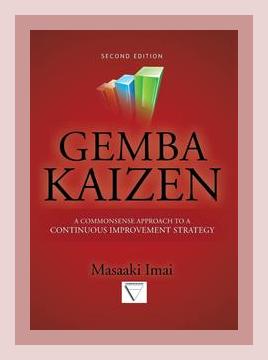Operations and Supply Chain ManagementProcess Improvement
**
Introduction to Gemba Kaizen
Gemba refers to the “real place” where work is done, and Kaizen means “continuous improvement.” Masaaki Imai, a pioneer in process improvement, emphasizes that real change happens not in the boardroom but on the factory floor, in the office, or wherever actual work occurs. The essence of the Gemba Kaizen approach is the relentless pursuit of waste elimination and small, incremental improvements that collectively make significant differences.
Action Item: Regularly visit the “Gemba” to observe, understand, and engage with the frontline processes and workers.
Core Principles of Gemba Kaizen
1. Waste Elimination (Muda, Mura, Muri)
- Muda (Waste): Activities that consume resources without adding value.
- Mura (Inconsistency): Variations that lead to defects and inefficiency.
- Muri (Overburden): Excessive strain on employees and equipment leading to breakdowns and accidents.
Example: Toyota Production System exemplifies waste elimination where they meticulously eliminate seven types of waste: overproduction, waiting time, transportation, processing, inventory, motion, and defective products.
Action Item: Conduct a waste walk to identify and categorize current waste, inconsistencies, and overburden in processes.
2. Standardization
Creating standardized processes helps in maintaining consistency and quality in operations.
Example: Canon’s approach to standardization ensures that every task is performed uniformly, enabling easier identification of deviations and faster improvements.
Action Item: Develop and document standard operating procedures (SOPs) for key processes in your organization.
3. 5S (Sort, Set in Order, Shine, Standardize, Sustain)
- Sort: Remove unnecessary items.
- Set in Order: Organize remaining items.
- Shine: Clean the work area.
- Standardize: Establish standards.
- Sustain: Maintain discipline to adhere to the 5S principles.
Example: A Japanese factory improved productivity significantly by implementing 5S, reducing the time spent searching for tools and materials.
Action Item: Launch a 5S initiative within your organization, starting with a specific area and expanding gradually.
Gemba Kaizen Tools and Techniques
1. PDCA Cycle (Plan-Do-Check-Act)
A systematic series of steps for gaining valuable learning and knowledge for the continual improvement of a product or process.
Example: A machinery manufacturer used the PDCA cycle to streamline their assembly line, reducing assembly time by 30%.
Action Item: Apply the PDCA cycle to a small project or specific problem, documenting each phase’s results and adjustments.
2. Visual Management
Using visual controls to make the status of work visible at a glance to ensure clear communication and quick response.
Example: At a food processing plant, colored bins were used for different waste types, simplifying sorting and reducing contamination rates.
Action Item: Implement visual management tools like kanban boards or color-coding in your workplace to enhance workflow clarity.
3. Just-In-Time (JIT)
Producing only what is needed, when it is needed, and in the amount needed to reduce inventory costs and increase efficiency.
Example: Dell applies JIT principles in their inventory management, drastically reducing storage costs and enhancing cash flow.
Action Item: Analyze inventory levels and adjust procurement processes to minimize excess stock while meeting demand.
Engaging Employees in Gemba Kaizen
1. Employee Empowerment and Involvement
Involving employees in decision-making and problem-solving processes ensures better insights and higher morale.
Example: A German car manufacturer established cross-functional teams that identified several opportunities for process improvement, leading to a 20% productivity boost.
Action Item: Create small, cross-functional teams to brainstorm and implement improvement ideas regularly.
2. Training and Development
Equip employees with the necessary skills and knowledge to contribute to Kaizen activities effectively.
Example: A manufacturing firm invested in Kaizen training workshops, resulting in employees independently identifying and implementing efficiency improvements.
Action Item: Organize continuous training sessions focused on problem-solving, process improvement, and Kaizen concepts for all levels of staff.
3. Recognition and Rewards
Acknowledging and rewarding contributions to Kaizen can significantly motivate employees.
Example: An electronics company implemented a reward system for employees who submitted valuable Kaizen suggestions, leading to a 25% increase in submitted ideas.
Action Item: Develop a recognition program that celebrates the best Kaizen initiatives and contributions regularly.
Implementing and Sustaining Continuous Improvement
1. Top Management Commitment
Strong leadership commitment is crucial for the success of Gemba Kaizen initiatives.
Example: At Honda, executives consistently support and participate in Kaizen activities, setting a precedent for the entire workforce.
Action Item: Ensure top management regularly participates in Gemba walks and Kaizen activities to demonstrate commitment.
2. Regular Audits and Review Mechanisms
Continuous auditing and review help sustain improvements and ensure alignment with goals.
Example: A logistics company conducts quarterly Kaizen audits to review progress and identify further improvement areas.
Action Item: Schedule and conduct regular audits of your process improvement activities to measure progress and recalibrate as needed.
3. Continuous Feedback and Adaptation
Gemba Kaizen is not a one-time task but an ongoing effort requiring constant feedback and adjustments.
Example: A software company implemented a feedback loop mechanism where suggestions from Kaizen activities are reviewed weekly and integrated into the workflow.
Action Item: Establish a continuous feedback mechanism where employees can provide input on process improvements and track the implementation of their suggestions.
Conclusion: The Impact of Gemba Kaizen
Gemba Kaizen offers a practical, commonsense approach to improving efficiency and productivity within any organization through perpetual small improvements and waste elimination. The success of Gemba Kaizen lies in the active engagement and empowerment of employees, robust leadership support, and an unwavering commitment to the principles of Kaizen and Gemba. By adhering to these principles and regularly applying the outlined tools and techniques, organizations can foster a culture of continuous improvement that consistently drives performance and quality.
In conclusion, Masaaki Imai’s “Gemba Kaizen: A Commonsense Approach to a Continuous Improvement Strategy” is not just a methodology but a mindset that, when embraced at all organizational levels, can lead to significant and sustainable improvements in operational efficiency and overall business success.
